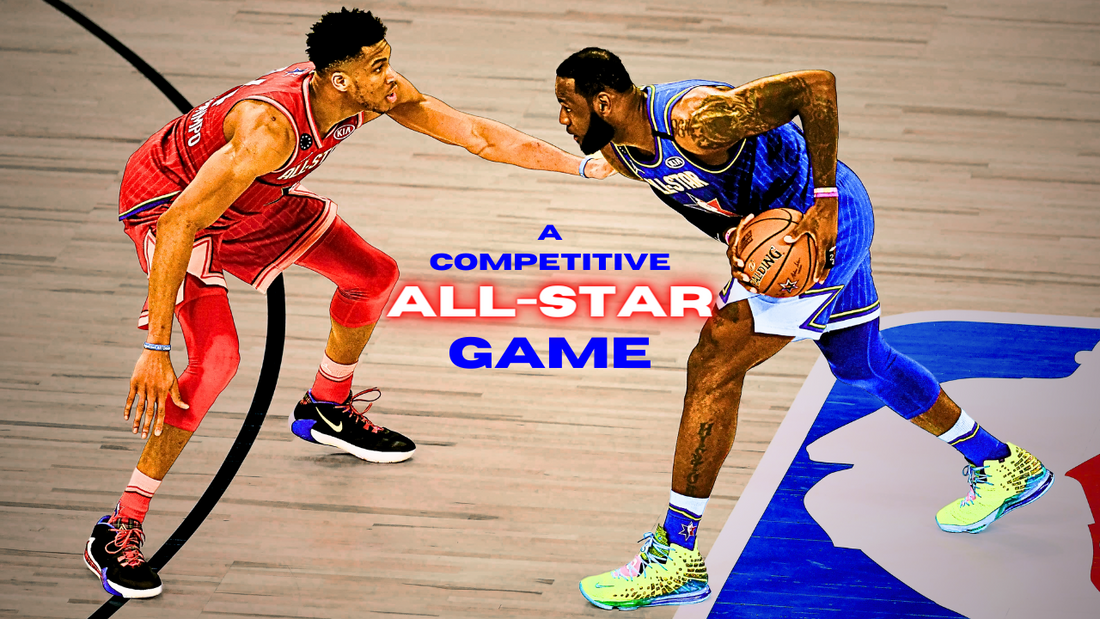Introduction: Peak into the 2003 All-Star Game
It’s 2003. The Terminator just became the Governor of California. Harry Potter is on book 5. Apple just debuted iTunes. Finding Nemo, Pirates of Caribbean. An 18-year-old LeBron James is getting ready for the NBA Draft. And Michael Jordan is appearing in his final All-Star Game.
The 2003 NBA All-Star Game stands out as one of the most star-studded events in history, boasting an unparalleled blend of talent and personality. The Western Conference All-Stars featured a formidable lineup of starters including Steve Francis, Kobe Bryant, Kevin Garnett, Tim Duncan, and Yao Ming, with Shaquille O’Neal, Shawn Marion, Dirk Nowitzki, Steve Nash, Gary Payton, Stephon Marbury, and Peja Stojakovic coming off the bench. Leading the West was Rick Adelman, the then head coach of the Sacramento Kings, with Peja stepping in as an injury replacement for Chris Webber.
On the Eastern Conference side, the All-Star roster boasted more legends such as Allen Iverson, Michael Jordan, Tracy McGrady, Jermaine O’Neal, and Ben Wallace as starters, complemented by Jason Kidd, Vince Carter, Paul Pierce, Brad Miller, Jamal Mashburn, Antoine Walker, and Zydrunas Ilgauskas off the bench. Guiding the Eastern team was Isiah Thomas, the coach of the Indiana Pacers at the time.
There are several features of the 2003 NBA All-Star Game that made it especially memorable.
To begin with, let's talk about the jerseys. This event marked the resurgence of NBA-designed All-Star Game jerseys, breaking a trend that had lasted since the '90s. In the five preceding years, players simply wore their own team jerseys during the All-Star Game. The new jerseys brought a wave of freshness, drawing inspiration from the retro designs of late '80s All-Star Game jerseys while opting for a looser fit over the traditional short shorts.
The spotlight of the All-Star weekend was undeniably on Michael Jordan, who was gearing up to retire for the third and final time. Despite controversy surrounding his selection, Jordan secured a starting spot and marked his 14th All-Star appearance. However, the Eastern Conference's starting backcourt, Allen Iverson and Vince Carter, both immensely popular in 2003, faced a dilemma. Carter, who had missed significant games due to injury that season, was pressured to yield his starting position to Jordan. Despite initial resistance, Carter eventually acquiesced, giving up his spot to his UNC predecessor just before tip-off.
Another intriguing aspect from the onset was Michael Jordan's coach for the game, Isiah Thomas, widely regarded as Jordan's most prominent rival and perhaps his greatest adversary. If Jordan had a sworn enemy, it was Zeke. However, Thomas had earned the coaching role for the night by guiding the Pacers to the best record in the Eastern Conference leading up to the break. Notoriously, there exists a conspiracy alleging that Isiah Thomas orchestrated a campaign to sideline Jordan during his inaugural All-Star Game in 1985. As a rookie, Jordan struggled, managing only seven points on a 22.2 percent shooting performance in a 140-129 defeat. Fast forward 18 years, encompassing two retirements and 13 additional All-Star appearances, and Michael Jordan emerged as the elder statesman in the All-Star Game, with Yao Ming being the sole rookie participant.
The first quarter saw a relatively competitive defensive showing from both teams, especially compared to the modern All-Star Game, with the East closing out the quarter with a 23-18 lead thanks to a 13-0 scoring run. Despite Jordan's shooting not reaching peak performance, he eventually set a record by tallying 20 points in the quarter.
As the game progressed, the pace and intensity notably increased, although defensive efforts waned once the reserves entered the game in the second quarter. The unmistakable flair of playground-style basketball permeated every aspect of the match, injecting a thrilling energy into the contest.
As per tradition, the fourth quarter proved to be more intense than the preceding periods. While Shaq dominated the minutes reserved for substitutes, most of the Eastern Conference starters remained on the court, even as the quarter commenced. Playing time was far from evenly spread, Isiah Thomas opting to play starters, with some bench All-Stars getting as low as four minutes played.
Michael Jordan, renowned as one of the most clutch players in NBA history, if not the most clutch, had clinched numerous victories and championships with his exceptional shot-making prowess in crucial moments. With just 10.1 seconds left and the score tied at 120, and a young Shawn Marion guarding him as overtime loomed, Jordan found himself in complete isolation. Initiating a post-up, he executed his trademark turnaround jumper after a few dribbles in the mid-post. However, the shot missed, eliciting a collective sigh from the crowd as it bounced off the rim, leading to overtime — marking the sixth occurrence of such an extension in All-Star game history. MJ would redeem himself in the 1st overtime where he again possessed the ball against Marion with the game on the line. With 10 seconds left, Jordan went to a right shoulder fadeaway that brought fans back to a glimpse of history (CLIP). But unfortunately for the East, Jermaine O’Neal would foul Kobe, sending him to the free-throw line, and the game into another overtime.
The 2003 All-Star Game represented a blend of entertainment and competitiveness. The players were true showmen, but didn’t compromise their defensive integrity. The game featured 37 personal fouls. Compare that to the most recent All-Star Game, where the East and West teams combined for 3 total personal fouls.
History of the All-Star Game
For the past few years, an annual discussion picks up following the All-Star Game, and quickly dissolves as the season picks back up. The conversation revolves around the question, “How do we fix the All-Star Game?” The discussion then turns to incentives for players like additional money, rewarding the team’s choice of charity, and some have suggested following the MLB’s incentive, giving the winning team guaranteed home-field advantage in the NBA Finals.
The buzz leading up to Sunday night's NBA All-Star Game revolved around efforts to enhance the game's competitiveness. Following the league's lowest-rated All-Star Game on record in 2023, which garnered a 2.2 rating and 4.59 million viewers, NBA Commissioner Adam Silver responded to the widespread criticism of the event with a series of proactive changes, following discussions with the players. The player draft, accompanied by lengthy introductions and a prolonged halftime show, was shelved in favor of reverting to the traditional East-West format, with a renewed emphasis on a "return to basketball," as Silver called. But even with this focus, fans were treated to one of the least competitive games of all time. I mean, a final score of 211-186 in 4 quarters is ridiculous.
The All-Star Game has always been a break, and players have never given playoff-like effort, but it seems to be getting increasingly less competitive. But it really wasn’t that long ago that All-Star Weekend featured one of the greatest, most intense games in its history.
In February 2020, during a timeless quarter on All-Star Sunday night, ten of the globe's premier athletes endured tense possession after tense possession. They absorbed charges, engaged in disputes with referees, leaped for blocks, and dove for loose balls. While Team LeBron emerged victorious on the scoreboard with a 157-155 win over Team Giannis, the true triumph was witnessed by the All-Star Game itself, revitalized with a vigor not experienced in quite some time (CLIPS.
With both the audience and players swiftly grasping the new regulations. Each of the initial three quarters featured a score "reset," with the winner of each quarter securing $100,000 for a designated charity. Then, the fourth quarter implemented a variation of the "Elam ending" format: the scores from the first three quarters were tallied, the game clock was deactivated, and the teams aimed for a target score—set at 24 points higher, in tribute to the recently passed Kobe Bryant, than the leading team's score at the start of the frame. So, with Team Giannis leading 133-124 after the third quarter, the teams directed their efforts towards reaching 157 points.
But reaching the target wasn't a straightforward task. In stark contrast to the swift, seamless possessions witnessed earlier in the game, the fourth quarter experienced both teams scrapping their way towards the target score, basket by strenuous basket (CLIPS of players talking about intensity).
A comparison of the statistics from the fourth quarter to those of the preceding three quarters reveals a starkly different style of play: less efficient offense, an increase in blocks and fouls, and a higher number of turnovers compared to assists.
To add to the playoff-feel, throughout the entirety of the fourth quarter, Nick Nurse, the coach of Team Giannis, maintained a consistent lineup: four starters consisting of Giannis Antetokounmpo, Joel Embiid, Pascal Siakam, and Kemba Walker, with Kyle Lowry stepping in for Trae Young. It’s worth mentioning that Lowrey still played for Nurse with the Raptors at the time, and was a crucial part of the game’s ending.
Meanwhile, the Team LeBron squad deployed its closing lineup early in the fourth quarter and opted not to make any substitutions thereafter. LeBron James was joined on the court by fellow starters Kawhi Leonard, Anthony Davis, and James Harden, with Chris Paul stepping in for Luka Doncic to create a cohesive unit of five seasoned veterans.
Similar to Team USA in the Olympics, where the choice of closing players reflects an honest assessment of their standing within the sport's hierarchy, these concluding lineup decisions shed light on the perceived status of the league's top stars.
For Team Giannis, their captain stepped up specifically on the defensive end. Nurse later revealed that Giannis requested specific defensive matchups down the stretch, and he certainly delivered. Contesting shots on both LeBron and AD (He spoiled LeBron's fadeaway attempt, disrupted an attempted Davis dunk), and in the closing moments, blocked a LeBron layup—initially ruled a goaltend, but was overturned after a replay review. Yes, this was an All-Star Game with late-game defense, reviewed plays and coach’s challenges.
The finale of the game was somewhat anticlimactic, especially in the moment. The intense battle ended on Anthony Davis free throws after a Kyle Lowry foul. But looking back, those free throws almost represent the nature of the fourth quarter. The fourth quarter alone featured 21 personal fouls, in part, a symbol of the effort players made during that quarter.
While the game ending in a free throw sparked some controversy, the Elam ending was ultimately successful that year. As a basketball experiment, the fourth quarter appeared to operate in a different realm altogether: devoid of a game clock, almost devoid of substitutions, and even free from interruptions by TV timeouts. Initially, the quarter assumed an almost surreal nature for an All-Star game—because it actually resembled competitive NBA basketball. However, the atmosphere quickly became familiar, transforming into a wildly entertaining spectacle. Exhaustion gripped the players while the fans showed no signs of letting up. The United Center fostered intense unity.
While All-Star Games will never have the start to end passion of playoff basketball, history teaches, that with the right storyline, the right rules, and a close enough contest, the NBA All-Star Game can be electric.

